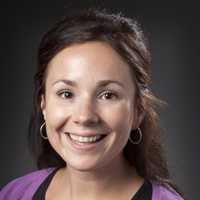
When asked to write an article about NCA’s Learning Outcomes in Communication (LOCs) and if I believed they would stand up in the new normal, my initial answer was yes, of course. After all, I had participated in the development of the LOCs. This multi-year, multi-phase project was some of the most intellectually stimulating work that I’ve been part of, outside of my dissertation. Faculty from all over the country, at all levels of rank, and from different types of institutions gathered to engage in this brain work. It challenged and changed my thinking and forced me to consider perspectives other than my classroom, my institution, and the transfer schools my students would attend. Instead, I had to think globally, while simultaneously thinking microscopically. This juxtaposition was difficult to navigate. I was reminded of big questions at every turn – Where does the discipline need to go? Where has it been? What do graduates with our degrees need to know? I needed to balance those big-picture questions with questions about the classroom – How do we get our students to those end outcomes? What does learning assessment look like in a classroom? There were intense, thoughtful discussions about how we could create outcomes that spoke to the breadth and depth of our discipline and curricular offerings.
It’s important to note that these outcomes were disseminated in 2015 as part of the National Communication Association’s (NCA) initiative to assist departments in formulating program-level outcomes. The LOCs are flexible and do not constitute a one-size-fits-all tool; rather, they are a set of standards that are responsive to a department’s curricular offerings and focus on articulating what graduates in Communication Studies should know, understand, and be able to do. According to the LOCs, graduates should be able to:
LOC 1: Describe the Communication discipline and its central questions.
LOC 2: Employ Communication theories, perspectives, principles, and concepts.
LOC 3: Engage in Communication inquiry.
LOC 4: Create messages appropriate to the audience, purpose, and context.
LOC 5: Critically analyze messages.
LOC 6: Demonstrate the ability to accomplish communicative goals (self-efficacy).
LOC 7: Apply ethical communication principles and practices.
LOC 8: Utilize communication to embrace differences.
LOC 9: Influence public discourse.
Certainly, educators had to be resilient during this unprecedented time in teaching and learning. I remember writing an email to my boss that ended with 'looking forward to precedented times.' Precedented. Give me the normal, routine, and mundane.
 In thinking about how to approach this piece, I settled on the idea of resilience. I know, I know, the topic of conventions and scholarship, resilience has received much focus. “Resilience” is used to describe the force individuals must exert to overcome and make sense of adversity. Certainly, educators had to be resilient during this unprecedented time in teaching and learning. I remember writing an email to my boss that ended with “looking forward to precedented times.” Precedented. Give me the normal, routine, and mundane. I was exhausted trying to cultivate a spirit of bouncing back, changing, juggling, and pivoting during trying semesters. Having moved to full-time online instruction during the Spring 2020 semester, continuing this for Summer 2020, Fall 2020, Spring 2021, and Summer 2021, and trying to balance five or six classes with full-time mothering of toddler twins, I longed for the predictable.
In thinking about how to approach this piece, I settled on the idea of resilience. I know, I know, the topic of conventions and scholarship, resilience has received much focus. “Resilience” is used to describe the force individuals must exert to overcome and make sense of adversity. Certainly, educators had to be resilient during this unprecedented time in teaching and learning. I remember writing an email to my boss that ended with “looking forward to precedented times.” Precedented. Give me the normal, routine, and mundane. I was exhausted trying to cultivate a spirit of bouncing back, changing, juggling, and pivoting during trying semesters. Having moved to full-time online instruction during the Spring 2020 semester, continuing this for Summer 2020, Fall 2020, Spring 2021, and Summer 2021, and trying to balance five or six classes with full-time mothering of toddler twins, I longed for the predictable.
During Patricie M. Buzzanell’s 2009 International Communication Association’s Presidential Address, she discussed the idea of resilience and asked, “What is this capacity to bounce back, to reintegrate, and to continue living at times when every waking moment is laborious?” (Buzzanell’s complete address can be found in the Journal of Communication, Volume 60.) There is, in my opinion, no better way to think about pandemic teaching (perhaps pandemic life, in general) than by exploring this question of resiliency. How does one continue in the face of consistent, daunting circumstances?
The circumstances do seem daunting. Across higher education, enrollment is down. The National Student Clearinghouse Research Center indicates in its “Stay Informed” series that ungraduated enrollment for the Spring 2021 semester was at its steepest decline (-5.9 percent) since the pandemic began. Community college enrollment declined by 11.9 percent. On the upside, graduate studies enrollment has increased by 4.4 percent. It is safe to reason that with fewer individuals enrolling in higher education, there are also declines in the numbers of Communication majors. Indeed, the data show declines of 4 – 6 percent in liberal arts and sciences, humanities, and social sciences – typically where we find Communication departments. In addition, in June 2020, Inside Higher Education and Hanover Research reported that college presidents are likely to reduce the number of academic programs offered by their institutions. Collectively, decreases in enrollment in universities and Communication programs, and potential cuts in academic programs create an environment where only the strong survive, an environment where campus leaders and faculty may be required to demonstrate the need for their courses, curricula, and programs. These are grim realities.
I tell anyone who will listen that communication is the backbone of life, that it can solve all problems, and that it is the competency our students, all students, need to be able to learn, reflect, and improve. To help demonstrate the need for our Communication Studies courses, I rely on the LOCs.
 Since 2010, I have been a professor at a community college. I love the purpose of a community college – accessible education, community engagement, and career preparation. The breadth of what can be done on these campuses seems big and important, and it is. My college is a multi-campus institution that served more than 58,000 students in 2020. We were fortunate to record growth in enrollment (about 1 percent) during the pandemic. The institution is building and opening new campuses to expand its reach in the community. Even still, I feel anxious about what will happen to our Communication Studies curriculum. In spite of the college’s growth, we currently offer fewer fields of study in Communication than we have in previous years. I am hopeful that we will return to offering more courses and credentials. I tell anyone who will listen that communication is the backbone of life, that it can solve all problems, and that it is the competency our students, all students, need to be able to learn, reflect, and improve. To help demonstrate the need for our Communication Studies courses, I rely on the LOCs.
Since 2010, I have been a professor at a community college. I love the purpose of a community college – accessible education, community engagement, and career preparation. The breadth of what can be done on these campuses seems big and important, and it is. My college is a multi-campus institution that served more than 58,000 students in 2020. We were fortunate to record growth in enrollment (about 1 percent) during the pandemic. The institution is building and opening new campuses to expand its reach in the community. Even still, I feel anxious about what will happen to our Communication Studies curriculum. In spite of the college’s growth, we currently offer fewer fields of study in Communication than we have in previous years. I am hopeful that we will return to offering more courses and credentials. I tell anyone who will listen that communication is the backbone of life, that it can solve all problems, and that it is the competency our students, all students, need to be able to learn, reflect, and improve. To help demonstrate the need for our Communication Studies courses, I rely on the LOCs.
COVID-19 certainly changed higher education. It feels too simple to say that the academic landscape is changing as a result of the pandemic, and too dismissive to say that the pandemic is simply exacerbating changes that were already occurring. The pandemic serves as a catalyst of sorts. It is a moment that allows us, as educators who shape young minds that contribute to the workforce and the world, to examine what is happening in our departments and what learning, skills, and competencies our graduates should leave us with.
Will the LOCs Remain Relevant?
So, where do we go with the LOCs? How resilient are they? I am reminded again of Patrice Buzzanell’s work on resilience. In Engaging Theories in Family Communication: Multiple Perspectives (2017), Buzzanell describes the communication theory of resilience and how it can be used by scholars. According to Buzzanell, the “goals of the communication theory of resilience are to understand and explain how people utilize discursive and material resources to constitute the new normal of their lives after disruption, loss, trauma, and disaster.” Resilience is a response triggered by some event; it is enacted with communicative practices. The COVID-19 pandemic was the event that triggered the need for resilience.
The LOCs were created in an easier time, and we hoped these outcomes would have utility for years to come. However, I am not sure any who contributed to the project dreamt we would be examining their helpfulness in a post-pandemic world. Yet, here we are, moving on and re-entering classrooms and spaces that have gone unused for more than a year. For those of us at institutions whose enrollment is declining, making the case for our programs and demonstrating their need seems vital. The LOCs can help support that process.
For those of us at institutions whose enrollment is declining, making the case for our programs and demonstrating their need seems vital. The LOCs can help support that process.
The LOCs were created through thoughtful reflection and question-asking. As we respond to the pandemic, we can call on these practices to determine how to utilize the LOCs. These practices speak to Buzzanell’s call to utilize discursive practices and engage in communication to renegotiate and create normalcy.
It goes without saying that the LOCs are based in the Communication discipline. But, they also equip graduates with transferable skills that have utility on a larger level. It seems obvious to say that students who complete a degree in Communication need to know something about the discipline (articulated in LOC 1). Having this knowledge provides graduates with a historical perspective and an awareness of the discipline’s relationship to other bodies of knowledge. At the heart of LOC 2 is the ability to use discipline-specific knowledge, which will be invaluable as graduates begin to navigate life post-college. LOC 3 builds from this understanding with its call to interpret and evaluate and engage in critical thinking. It’s this careful thinking that one must be able to practice as they “read the room” and determine what verbal and nonverbal communication is contextually appropriate (LOC 4). It may be more important than ever to be able to evaluate messages (LOC 5). Pandemic information aside, the deluge of information that is readily available and seemingly continuous can result in sensory overload. Separating fact from fiction is a necessary life skill for our students. LOC 6 cultivates a growth mindset. It points to the idea that skills are not stationary; rather, as mindful adults, we can take stock, understand, reflect, and change if needed. Being ethical isn’t hard but understanding other’s ethical perspectives can be (LOC 7). We need our graduates to engage in and be mindful of their own and others’ ethical standards.
In a June 2021 article titled “Don’t Downplay the Role of Community Colleges in Healing a Nation,” Eduardo Padron advocates that community colleges are uniquely positioned to help our students connect to their communities and that this benefits them beyond the classroom standards of excellence. He goes on to write that “The students whose minds we seek to inspire on campus become the architects of the policies and practices that shape the future of US society.” How poetically accurate! Our students become decision makers. Shouldn’t we give them an opportunity to acquire skills in being thoughtful, sound, fair decision makers? We live in an increasingly diverse world that is (beginning) to embrace that diversity. As Communication teachers, we would be setting our students up for disaster if we didn’t provide them with programs that gave voice to both similarities and differences (LOC 8).
I unapologetically tell my students that communication can solve all of life’s problems. This may err on the side of hyperbole, but I am a firm believer that if I want my (by-and-large) first-year, fresh-from-high-school college students to understand the power of communication, then I better offer them statements that speak to its importance. I do believe that communication solves problems, that communication is this big, important, too-often-labeled-as-easy skill that has real power. It has power that extends beyond a classroom experience. It. Is. Your. Daily. Life. The bigness of that is not lost on me, and I try desperately for it to not be lost on my students. You are living this. You have an obligation to use your communication skills and knowledge to take care of the world in which you live (LOC 9).
So, I circle back to Buzzanell’s 2010 call. How do we keep going when things seem insurmountable? With careful thinking, learning, interpreting, planning, and evaluating – all of which are embedded components of the LOCs. So, are the LOCs resilient? Yes. Can they help us meet the challenges of the new normal? Yes. Can they be adopted and adapted by departments to meet the faculty and student needs of their particular institutions? Yes. Through careful reflection among faculty and discussions of what each brings to the table in combination with course offerings and end states they seek to get students to, these LOCs can be used to help students cultivate their own resilience. Cultivating resilience is an ongoing endeavor; a work in progress. Let us strive to create resilient programs that provide our students with the communication skills and knowledge that will equip them for success in the world.
ABOUT THE AUTHOR

KERRY BYRNES-LOINETTE is Professor of Communication Studies at Collin College, Plano Campus, where she has taught since 2010. A recipient of NCA’s Michael and Suzanne Osborn Community College Outstanding Educator Award and an ECA Distinguished Teaching Fellow, Byrnes-Loinette’s scholarship focuses on best teaching practices and assessment in the community college classroom.

